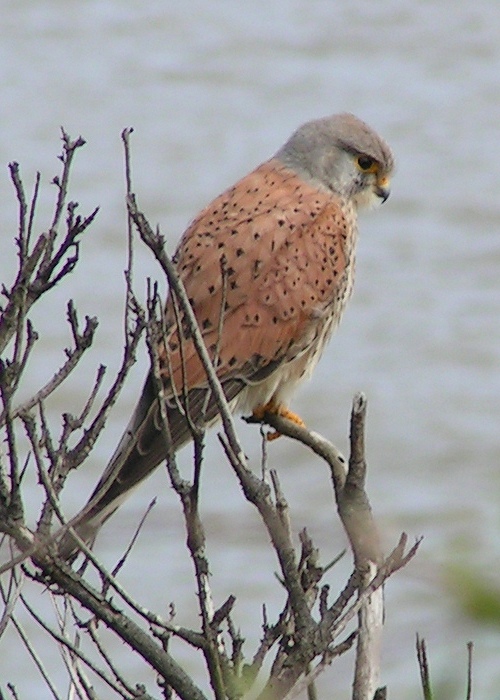- Kestrel
Taxobox
name = Kestrel

image_width = 250px
image_caption = Adult male Common Kestrel
regnum =Animal ia
phylum =Chordata
classis =Aves
ordo =Falconiformes
familia =Falconidae
genus = "Falco" ("partim")
subdivision_ranks =Species
subdivision = See text.The name kestrel is given to several different members of thefalcon genus, "Falco". Kestrels are most easily distinguished by their typical hunting behaviour which is to hover at a height of around 10–20 m over open country and swoop down on prey, usually small mammals, lizards or large insects. Other falcons are more adapted to active hunting on the wing. In addition, kestrels are notable for usually having much brown in their plumage.Kestrels require a slight headwind in order to hover, hence a local name of "windhover" for
Common Kestrel .Plumage often—but unusually for falcons—differs between male and female, and (as is usual with
monogamous raptors) the female is slightly larger than the male. This allows a pair to fill different feeding niches over their home range. Kestrels are bold and have adapted well to human encroachment, nesting in buildings and hunting by major roads.Kestrels do not build their own nests, but use nests built by other species.Most
species termed kestrels appear to form a distinctclade among the falcons, as suggested by comparison ofmtDNA cytochrome "b" sequence data (Groombridge "et al." 2002 [See there for a careful discussion of the divergence times mentioned in this article.] )and morphology. This seems to have diverged from other "Falco" around theMiocene -Pliocene boundary (Messinian toZanclean , or about 7–3.5 mya). The most basal "true" kestrels are three species from Africa and its surroundings which lack amalar stripe, and in one case have—like other falcons but unlike other true kestrels—large areas of gray in their wings.Approximately during the
Gelasian (Late Pliocene orEarly Pleistocene , around 2.5–2 mya), the main lineage of true kestrels emerged; this contains the species characterized by a malar stripe. This too seems to haveevolved in Africa and subsequently spread across theOld World until they reached Australia some time during theMiddle Pleistocene , less than one million years ago. This group contains severaltaxa found on Indian Ocean islands.More enigmatic is a group of 3 predominantly gray species from Africa and Madagascar. These are usually considered kestrels due to their general shape and habits, but are probably more quite distinct from the true kestrels as outlined above.
The American Kestrel is the only
New World species termed "kestrel". Actually, the molecular data of Groombridge "et al." (2002), as well as morphological peculiarities (like grey wings in males and a black ear-spot) andbiogeography , strongly support the view that this species, among the "Falco" falcons, is not a kestrel at all in thephylogenetic sense but perhaps closer to the hobbies.Malar-striped clade or Common Kestrel group
*Madagascar Kestrel , "Falco newtoni"
*Seychelles Kestrel , "Falco araea"
*Mauritius Kestrel , "Falco punctatus"
*Réunion Kestrel , "Falco duboisi" -extinct (c.1700 )
*Spotted Kestrel , "Falco moluccensis", found inIndonesia
*Nankeen Kestrel or Australian Kestrel, "Falco cenchroides", found inAustralia andNew Guinea
*Common Kestrel , "Falco tinnunculus", found inEurope ,Asia , andAfrica
** Rock Kestrel, "Falco tinnunculus rupicolus", found in South AfricaBasal lineage(s) of true kestrels
*Greater Kestrel , "Falco rupicoloides", found in Eastern to South Africa
*Fox Kestrel , "Falco alopex", found in Equatorial Africa
*Lesser Kestrel , "Falco naumanni", found in southernEurope ,India , and most ofAfrica except for theSahara and equatorial forest areasAfrican gray kestrels (a more distant group)
*Grey Kestrel , "Falco ardosiaceus", found in Central to Southern Africa
*Dickinson's Kestrel , "Falco dickinsoni", found in Eastern to Southern Africa
*Banded Kestrel , "Falco zoniventris", found onMadagascar American Kestrel
*American Kestrel , "Falco sparverius", found inNorth America andSouth America Footnotes
References
*
External links
* [http://www.ibercajalav.net/img/131_KestrelFtinnunculus.pdf Identification guide (PDF) by Javier Blasco-Zumeta]
Wikimedia Foundation. 2010.
